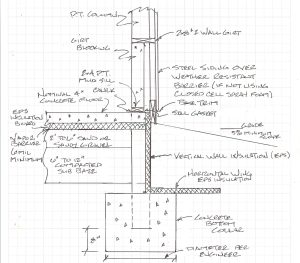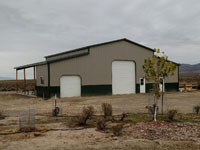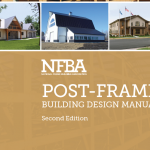Barndominium Concrete Slab Insulation Boards – XPS or EPS?
Other than in Climate Zone’s 1 and 2 (think deep South), International Energy Conservation Code (IECC) requires perimeter and under slab continuous insulation for barndominiums.
When it comes to concrete and insulation, contractors tend to be most familiar with extruded polystyrene (XPS). Yet, expanded polystyrene (EPS) performs as well or better than XPS, and at a substantially lower cost. Three important factors to consider when comparing these two insulations for any below grade or under-slab application are compressive strength, moisture retention, and insulating capability.
Weight of concrete slabs and foundation backfill may imply highest strength insulation is most sensible. For many jobs, though, products with less compressive strength are more than sufficient and can reduce insulation costs. For example, installing a below-grade insulation rated for 100 psi, when only 40 psi is needed, will nearly double material costs.
Many designers mistakenly assume loads placed on slabs transfer through to underlying insulation and soil at a 45-degree angle instead of a more uniform distribution. This can result in greatly over-designing insulation’s strength. For example, with a forklift load on a typical 4-inch-thick slab, one calculation would indicate 32 psi is applied to insulation compared to only 2.5 psi under a more accurate calculation. As such, it is not uncommon for under slab insulation to be over-designed by a factor of 10 or more.
Using unnecessarily high-strength insulation, you end up paying for something you don’t really need. Since EPS is lower cost per inch than XPS, and is available in a range of compressive strengths (from 10 to 60 psi), using it below grade and under slabs can save on insulation costs.

A common question with rigid foam insulations is how well it resists water. A number of studies show EPS retains less moisture than XPS. A case in point is a side-by-side analysis of these two rigid foam types installed on a commercial building foundation in St. Paul, MN. When extracted and tested after 15 years in service, EPS had 4.8% moisture content by volume, compared to 18.9% for XPS (a four-fold difference). A testing lab also found XPS holds water longer than EPS. After 30 days of drying time, XPS still had elevated moisture of 15.7%, while EPS had dried to 0.7%.
For installations where insulation will be exposed to large amounts of water or frequent wetting, rigid foam insulation is available with water-resistant facers or pre-cut drainage grooves. Insulation with polymeric laminate facers keep water from entering insulation and also provide an added barrier to water wicking or diffusing through foundations and slabs.
Moisture resistance is also important for below grade and under-slab insulation, since wet products provide much lower thermal resistance. Side-by-side insulation comparison found EPS retained 94% of its specified R-value, while XPS lost nearly half of its insulating capability over 15 years.
In addition to higher moisture resistance, EPS also is not subject to thermal drift. This means its R-value stays the same over time. By comparison, XPS’s manufacturing process uses blowing agents diffusing from foam’s cellular structure over product life, thereby reducing its thermal performance. EPS manufacturers typically warrant 100% of published R-value for 20 years or more, while common XPS warranties cover just 90% of published R-value.
Whether selecting EPS or XPS insulation, to ensure performance, confirm the product was manufactured to meet requirements of ASTM C578, Standard Specification for Rigid, Cellular Polystyrene Thermal Insulation. This standard provides a key quality check on rigid insulation.
As insulation becomes increasingly common under slabs, understanding performance and cost factors of these different materials is important. EPS offers a number of advantages over more commonly installed XPS, including having highest R-value per dollar among rigid insulations, making it a cost effective choice for many jobs.









How do GPS foams or spraying down a bed of closed-cell compare?
In order to provide an adequate condensation barrier closed cell spray foam should be 2″ thick, providing R-14 at a cost of roughly $2 per square foot. GPS foam is R-5 per inch, so would need to be at least 2.8″ thick at $2.10 per square foot. Foam boards should not typically be placed between wall girts and steel siding, as it will severely impact wind shear carrying capacity of steel siding.